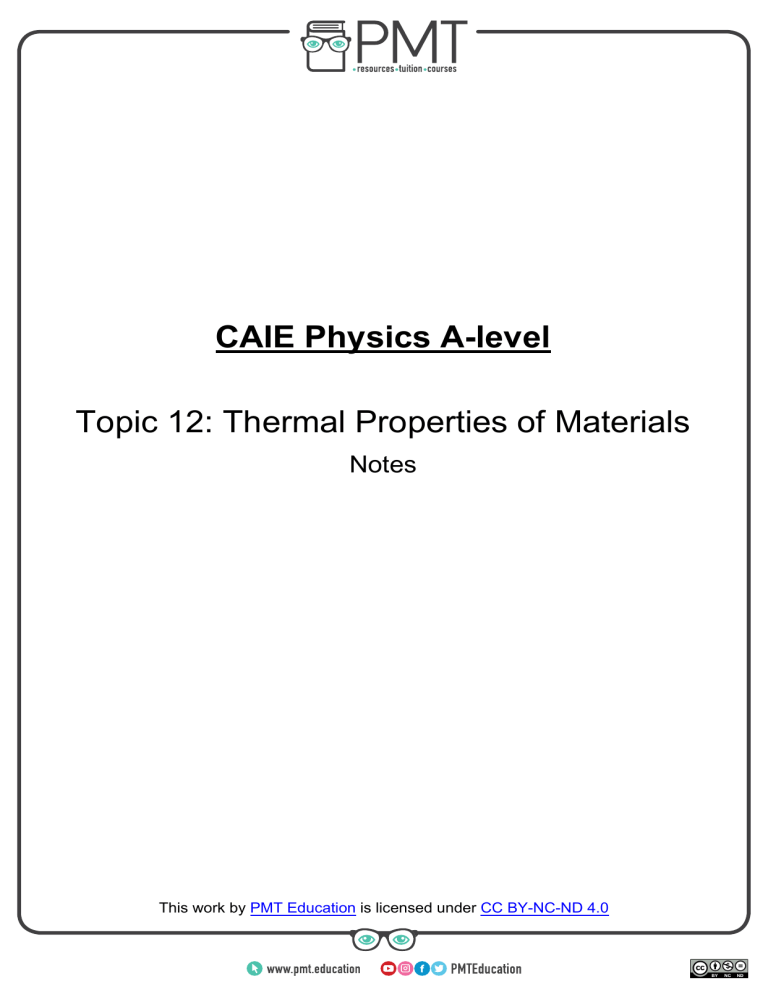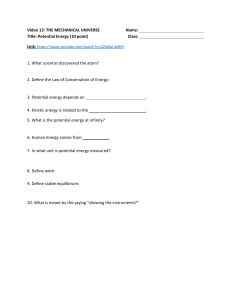Notes - Topic 12 Thermal Properties of Materials - CAIE Physics A-level
advertisement

CAIE Physics A-level Topic 12: Thermal Properties of Materials Notes https://bit.ly/pmt-edu-cc This work by PMT Education is licensed under https://bit.ly/pmt-cc CC BY-NC-ND 4.0 https://bit.ly/pmt-edu https://bit.ly/pmt-cc https://bit.ly/pmt-cc 12 - Thermal Properties of Materials (A-level only) 12.1 - Specific Heat Capacity and Specific Latent Heat The kinetic model of matter can be used to explain the structure of solids, liquids and gases. This model is based on the following suggestions: ● Matter is formed of particles ● The particles can move ● The particles experience intermolecular forces Most substances experience 3 distinct phases, which are determined by the energy of the substance. These phases are solid, liquid and gas, and can be explained using the kinetic model as below: ➔ Solid - Particles are fixed but can vibrate since the intermolecular forces are large. Particles are very close together. ➔ Liquid - Particles have more energy, are much more free to move and are further apart than in a solid. Intermolecular forces are smaller than in a solid but still relatively large. ➔ Gas - Particles are much further apart and can move even more freely since th intermolecular forces are very weak. Particles have more energy than in a liquid. Image source: OpenStax CNX,CC BY 4.0 The internal energy of a body is equal to the sum of all of the kinetic energies and potential energies of all its particles. The kinetic and potential energies of a body are randomly distributed. When the state of a substance is changed, its internal energy also changes. This is because the potential energy of the system changes, whilst the kinetic energy of the system is kept constant. This can be demonstrated by measuring the temperature of water as it boils and melts: ● Boiling The temperature increases up until 100°C, after which the energy gained through heating the water is no longer used to increase the temperature (and therefore kinetic energy), but instead is used to break bonds between water molecules so it can change state to water vapour, and so the potential energy is increased. ● Melting The temperature of ice increases up until 0°C, after which the energy gained through heating the water is no longer used to increase the temperature, but instead is used to break bonds between water molecules so it can change state to liquid water, and so the potential energy is increased. https://bit.ly/pmt-edu https://bit.ly/pmt-cc https://bit.ly/pmt-cc Below is a graph showing how the internal energy of a substance varies with temperature: The specific heat capacity of a substance is the amount of energy required to increase the temperature of 1 kg of a substance by 1 °C/1 K, without changing its state. You can measure the amount of energy required to change the temperature of a substance using the following formula: Q = mcΔθ Where Q is energy required, m is the mass, c is the specific heat capacity, and Δθ is the change in temperature. The specific latent heat of a substance is the amount of energy required to change the state of 1 kg of material, without changing its temperature. There are two types of specific latent heat: the specific latent heat of fusion (when solid changes to liquid) and specific latent heat of vaporisation (when liquid changes to gas). You can measure the amount of energy required to change the state of a substance using the following formula: Q = ml Where Q is energy required and l is the specific latent heat. The specific latent heat of vaporisation is usually larger than the specific latent heat of fusion of the same substance as more intermolecular bonds must be broken (so more work must be done) to change a substance from a liquid to a gas, than when changing from a solid to a liquid. As mentioned above, the kinetic energies of particles in a liquid will be random and once a particle in a liquid gains enough energy, it will leave the liquid and evaporate, leaving behind particles with lower kinetic energies. Therefore the kinetic energy of particles decreases and as kinetic energy is proportional to temperature, the temperature of the liquid will decrease. Image source: OpenStax CNX,CC BY 4.0 https://bit.ly/pmt-edu https://bit.ly/pmt-cc https://bit.ly/pmt-cc You can calculate the specific heat capacity (c) of a material by: ● Measuring the mass of the material that will be heated (m) using a top-pan balance ● Measuring the energy input into the material (Q) by calculating the power input by the heater (using values of voltage and current) and multiplying this by the time it is turned on ● Calculating the temperature change (Δθ) by finding the difference between the initial and final temperatures And then using the following formula: Q c = mΔθ The calculated specific heat capacity will be larger than the actual value due to energy losses to the environment through resistance in the wires in the circuit, and heat being radiated away from the material. Energy losses to the environment can be decreased by insulating the material. Below is a diagram for an experiment finding the specific heat capacity of aluminium: You can calculate the specific latent heat (l) of a material by: ● Measuring the energy input into the material (Q) by calculating the power input by the heater (using values of voltage and current) and multiplying this by the time it is turned on. ● Measuring the change in mass of the material (m) - this will either be a gain in mass when calculating latent heat of fusion or a loss in mass when calculating latent heat of vaporisation. This value will give an indication of the mass of the material which has changed state. Then use the following formula: Q l= m Again energy gains/losses to the environment will affect the calculated value of specific latent heat. You can reduce their effect by measuring the energy gained/lost before the heater is switched on, however this value will vary. https://bit.ly/pmt-edu https://bit.ly/pmt-cc https://bit.ly/pmt-cc Below are the equipment diagrams for experiments finding the latent heat of fusion (left) and latent heat of vaporisation (right). 12.2 - Internal Energy and the First Law of Thermodynamics The internal energy of a body is equal to the sum of all of the kinetic energies and potential energies of all its particles. The kinetic and potential energies of a body are randomly distributed. The internal energy of a body is dependent on its state, since the state of a body is determined by the value of the kinetic energies of particles. The internal energy of a system can be increased in two ways: 1. Do work on the system to transfer energy to it (e.g moving its particles/changing its shape) 2. Increase the temperature of the system The kinetic energy of particles is directly proportional to their temperature, therefore an increase in temperature means an increase in the average kinetic energy and so an increase in internal energy. The first law of thermodynamics describes the conservation of energy in a system where energy can be transferred through doing work or heating. It states that the increase in internal energy of a system is equal to the sum of the energy transferred to it through heating and work done on the system. It is given by the following equation: ΔU = Q + W https://bit.ly/pmt-edu https://bit.ly/pmt-cc https://bit.ly/pmt-cc In the above equation: ➔ ΔU represents the increase in internal energy, if ΔU is negative, the internal energy will decrease. ➔ Q is the energy transferred to the system through heating, therefore if Q is negative, energy is transferred away from the system through cooling. ➔ W is the work done on the system (occurs when a gas is compressed), therefore if W is negative, work is done by the system (occurs when a gas expands). The diagram below shows a system which does work. This is shown by the fact that W is negative. Image source: OpenStax College,CC BY 4.0 https://bit.ly/pmt-edu https://bit.ly/pmt-cc https://bit.ly/pmt-cc





